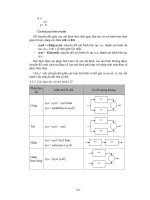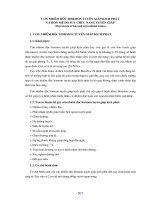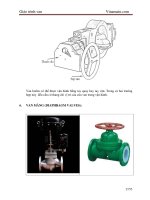GIÁO TRÌNH MARKETING NGHIÊN CỨU - PHẦN 20 ppsx
Bạn đang xem bản rút gọn của tài liệu. Xem và tải ngay bản đầy đủ của tài liệu tại đây (764.28 KB, 34 trang )
The Marketing
Research Report:
Preparation and
Presentation
Ch 20 2
The Marketing Research Report
•
Marketing research report: a factual
message that transmits research
results, vital recommendations,
conclusions, and other important
information to the client, who in turn
bases his or her decision making on
the content of the report
Ch 20 3
The Importance of the Marketing
Research Report
•
The client bases his or her decision
making on the contents of the report.
•
The marketing research report is the
product that represents the efforts of the
marketing research team, and it may be
the only part of the project that the client
will see.
•
The time and effort expended in the
research process are wasted if the
report does not communicate effectively.
Ch 20 4
Organizing the Written Report
•
Marketing research reports are tailored to
specific audiences and purposes, and you must
consider both in all phases of the research
process, including planning the report.
•
Must consider questions such as:
–
What is your purpose?
–
Who is the audience?
–
What are your audience’s interests, values,
concerns?
Ch 20 5
Organizing the Written Report
Ch 20 6
Organizing the Written Report
•
The front matter consists of all pages
that precede the first page of the report.
•
The title page contains the title of the
document, the organization/person(s) for
whom the report was prepared, the
organization/person(s) who prepared the
report, and the date of submission.
•
The letter of authorization is the
marketing research firm’s certification to
do the project and it is optional.
Ch 20 7
Organizing the Written Report
•
The letter of transmittal is used to
release or deliver the document to an
organization for which you are not a
regular employee.
•
The memo of transmittal is used to
deliver the document within your own
organization.
Ch 20 8
Organizing the Written Report
•
The table of contents helps the reader
locate the information in the research
report.
•
The list of illustrations helps locate
tables or figures within the report.
–
Tables are words or numbers that
are arranged in rows and columns.
–
Figures are graphs, charts, maps,
pictures, and so on.
Ch 20 9
Organizing the Written Report
Ch 20 10
Organizing the Written Report
Ch 20 11
Organizing the Written Report
Ch 20 12
Organizing the Written Report
•
Abstract/executive summary: skeleton
of your report
•
Body: bulk of the report, including
introduction, explanation of method,
discussion of results, statement of
limitations, and a list of
recommendations and conclusions
Ch 20 13
Introduction
•
The introduction may contain:
–
A statement of the background
situation leading to the problem
–
The statement of the problem
–
A summary description of how the
research process was initiated.
Ch 20 14
Introduction
•
It should contain a statement of the
general purpose of the report and
also the specific objectives for the
research.
•
Research objectives may be listed
here or in a separate section.
Ch 20 15
Organizing the Written Report
•
Method describes in detail how the
research was conducted, who (or what)
the subjects were, and what methods
were used to achieve the objectives
•
Methodology refers to the science of
determining appropriate methods to
conduct research.
•
Method refers to the tools used in a
scientific investigation.
•
Use method, not methodology!
Ch 20 16
Organizing the Written Report
•
Results present the findings of the
research.
•
Limitations may focus on, but not
limited to, time, money, personnel, and
size of population.
Ch 20 17
Organizing the Written Report
•
Conclusions are the outcomes and
decisions you have reached based on
your research results.
•
Recommendations are suggestions for
how to proceed based on the
conclusions.
•
The end matter contains information that
the reader may need to refer to for
further reading but that is not essential to
reporting the data.
Ch 20 18
Plagiarism
•
Plagiarism refers to presenting the
work of others as your own and is a
serious offense.
–
If you are in doubt, document!
Ch 20 19
Following Guidelines and
Principles for the Written Report
•
Headings indicate the topic of each
section.
•
Subheadings should divide that
information into segments.
•
Visuals are tables, figures, charts,
diagrams, graphs, and other graphic
aids.
Ch 20 20
A Tip to Make You a Better
Writer…Use Subheadings!
•
TITLE
•
FIRST-LEVEL HEADING
•
Second-Level Heading
•
Third-Level Heading
•
Fourth-Level Heading.
•
Fifth-Level Heading – part of the sentence
•
See MRI 20.3, p. 611
Ch 20 21
Style
•
Stylistic devices can make the
difference in whether or not your
reader gets the message as you
intended it.
–
Examples:
•
A good paragraph has one main
idea… See MRI 20.4 on p. 612.
•
Capitalize on white space.
Ch 20 22
Using Visuals:
Tables and Figures
•
Tables identify exact values; allow
reader to compare numerical data.
Ch 20 23
Ch 20 24
Using Visuals:
Tables and Figures
•
Charts:
•
Pie charts: circle divided into
sections; compare a specific
part of the whole to whole
Ch 20 25









